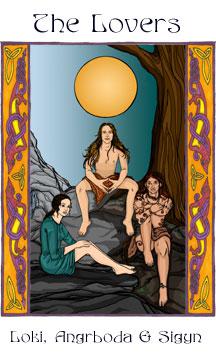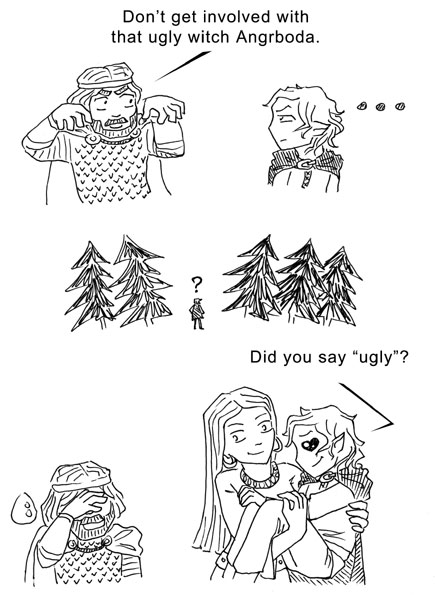Dear readers,
welcome to the second year of the Pagan Blog Project! This year’s project will be slightly different in two ways: first,
there is now a page where bloggers can both post their weekly entries, as well
as connect to others in the forum; and second, since I’m focussing my practice
on Loki, I have decided to try and attempt to post a Northern Tradition-related
topic in the first week for each letter, followed by a Celtic or more general
topic for the second week. This way, if you’re only interested in one
tradition, it’s easier for you to keep track of relevant posts.
In the first post of this year, I will
focus on Angrboda, the Hag of the Iron Wood, Loki’s first wife.
As She is a Jotnar, most practitioners don’t
subsume Her under Gods or beings worthy of worship. If you only browse the
internet for five minutes, you’ll find many pages that express a certain
dislike, if not outright hate towards Her.
This is because as Loki’s first wife, She
gave birth to Hela, goddess of death, the wolf Fenrir and Jormungandr, the
Midgard serpent, and (according to some sources) also to the two wolves who
will swallow the sun and the moon at Ragnarök. Her children are regarded as abominations,
as monsters – Fenrir will be Odin’s killer, and Thor will die in a fight with Jormungandr.
Further, concerning Loki, there is the implication that He sired monsters with
Her before moving on to Sigyn as a “real”, proper wife (Krasskova 2008: 159).
And finally, since Loki is blamed for the death of Balder and the coming of
Ragnarök, anything and anyone associated with Him cannot be a ‘good’ person to
worship.
Loki and His two wives, Sigyn and Angrboda
However, to Her worshippers – and there are
quite a few, see e.g. the online shrines maintained in Her honour – She is not
an evil witch or old hag, but a mother figure. After all, She is mother to almost
the whole Rökkr pantheon. And further, the word hag, when related to hagia, describes
Her as a wise woman (1).
Also, Angrboda should be of concern to
everyone who follows a Northern Tradition path, since She did not only bear “monsters”,
but is also mother to Gerda, Frey’s beautiful wife.
A myth tells us that Angrboda was thrice
burned by the Aesir because She lured Freyja, Whose messenger She had become,
away from Asgard. After the third burning, Loki consumed Her heart (which He seems
to do with quite some of His followers/wives) and gained the ability to give
birth.
As Gerda’s mother, She has relations to the
Vanir, who felt that an attack on Angrboda was also an attack on Them; however,
the Aesir refused to pay the appropriate wergild, and thus the first war between
the Gods ensued. Whether you do or don’t follow the interpretation that it was
Angrboda’s plan all along to create discord between the Gods is another matter
that I won’t go into detail here, but I’m interested in your opinion in the
comments.
If you want to get to know Angrboda, you
will discover a strong-willed, straightforward, no-nonsense woman Who requires
you to make a firm stance. She doesn’t tolerate whiny people and expects you to
work hard on yourself (Krasskova 2008: 160).
As a mother, She isn’t one to cuddle close
to, but one who advocates a “wolflike”, pragmatic mothering (1); in contrast to
the more gentle mother goddesses, She is lending help to the “inner adolescent”,
the inner problem teen (Krasskova 2008: 161). She is very protective of Her “pack”,
although She doesn’t allow everyone to join Her. However, Her selective
criteria aren’t your looks or your ancestry, but what you’ve got inside of you
(2).
If She takes you under Her wing, Her gifts
are motivation and protection. She tells “different” people that they are
perfect the way they are, and She is a good role model for strong women and
women in positions of leadership. Finally, She is also a good associate for
queer and trandgender people as well as for the polyamorous (1).
If you decide to worship Her, there’s a
list of suggestions for an altar to Her that Galina Krasskova and Raven Kaldera
have compiled in their wonderful book Northern
Tradition for the Solitary Practitioner (and, for some reason, most of Loki’s
followers seem to end up solitary):
colours: russet, dried-blood red (She is
often described as a red-haired warrior), dark green
symbols: wolf, nine stones
altar suggestions: wolves and wolf skins,
nine stones or other objects for the clans of the Iron Wood, jet, flint knife,
oak bough, thistles, agrimony, lupines, the rune Ac
food and drink: Jack Daniels whisky, red
and white meat, especially game
service offerings: do something challenging
for yourself; another source mentioned donating to local wildlife/wolf
preservation funds
contraindicated: whining; placing Her altar
next to anything Aesir or Alfar (Krasskova & Kaldera 2009: 228).
So how do you see Angrboda? Is She the Hag
of the Iron Wood unworthy of our worship, or is She Loki’s beloved first wife,
and should therefore be included in our practice?
Blessed be,
Harzgeist
Harzgeist
references:
books:
Krasskova, Galina and Raven Kaldera. 2009. Northern Tradition for the Solitary Practitioner.
A Book of Prayer, Devotional Practice, and the Nine Worlds of Spirit.
Franklin Lakes, NJ: Career Press.
Krasskova, Galina. 2008. Feeding the Flame. A Devotional to Loki and
His Family. Hubbardston, MA: Asphodel Press.
online shrines:
list of links with poetry about Her: http://www.northernpaganism.org/shrines/angrboda/writing.html
images:
Loki and His two wives: http://www.northernpaganism.org/assets/images/Angrbodapics/trumps06-LokiAngrbodaSigyn.jpg
Loki and Angrboda:
Angrboda comic:



Keine Kommentare:
Kommentar veröffentlichen